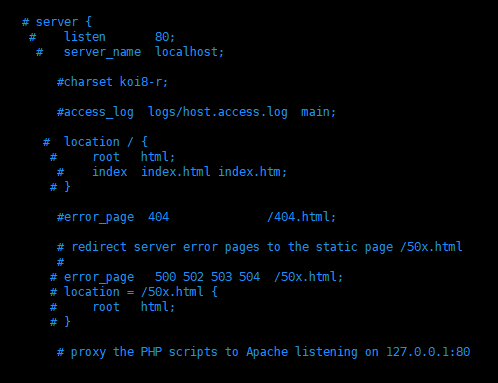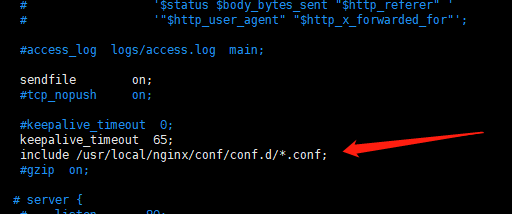搭建nginx
Nginx ("engine x") 是一个高性能的HTTP和反向代理服务器,也是一个IMAP/POP3/SMTP服务器。Nginx是由Igor Sysoev为俄罗斯访问量第二的Rambler.ru站点开发的,第一个公开版本0.1.0发布于2004年10月4日。其将源代码以类BSD许可证的形式发布,因它的稳定性、丰富的功能集、示例配置文件和低系统资源的消耗而闻名。关于Nginx的优点,我在这里就不讨论了,网上的资料多的是
通常nginx 有两种搭建方法一个是yum 源安装, 一个是编译安装 ,前者安装方便 ,后者更灵活,可以根据自己的需要安装一些模块
安装前先安装环境依赖
yum install gcc gcc-c++ automake pcre pcre-devel zlip zlib-devel openssl openssl-devel
yum 安装nginx
安装nginx源
yum localinstall http://nginx.org/packages/centos/7/noarch/RPMS/nginx-release-centos-7-0.el7.ngx.noarch.rpm
安装nginx
yum install nginx
启动nginx
service nginx start
别的命令 service nginx stop 停止 service nginx restart 重启
编译安装nginx
下载nginx 安装包: 官网地址:http://nginx.org/
wget http://nginx.org/download/nginx-1.8.1.tar.gz
然后解压安装包
[root@bob ~]# tar xvf nginx-1.8.1.tar.gz [root@bob ~]# cd nginx-1.8.1 [root@bob nginx-1.8.1]$ ls auto CHANGES CHANGES.ru conf configure contrib html LICENSE man README src
编译nginx 配置好位置,模块 ,参数
./configure --prefix=/usr/local/nginx --sbin-path=/usr/local/nginx/sbin/nginx --conf-path=/usr/local/nginx/conf/nginx.conf --error-log-path=/var/log/nginx/error.log --http-log-path=/var/log/nginx/access.log --pid-path=/var/run/nginx/nginx.pid --lock-path=/var/lock/nginx.lock --user=nginx --group=nginx --with-http_ssl_module --with-http_stub_status_module --with-http_gzip_static_module --http-client-body-temp-path=/var/tmp/nginx/client/ --http-proxy-temp-path=/var/tmp/nginx/proxy/ --http-fastcgi-temp-path=/var/tmp/nginx/fcgi/ --http-uwsgi-temp-path=/var/tmp/nginx/uwsgi --http-scgi-temp-path=/var/tmp/nginx/scgi --with-pcre
执行完毕后
make
make install
安装完成后 /usr/local/nginx 有对应的文件
conf:保存nginx所有的配置文件,其中nginx.conf是nginx服务器的最核心最主要的配置文件,其他的.conf则是用来配置nginx相关的功能的,例如fastcgi功能使用的是fastcgi.conf和fastcgi_params两个文件,配置文件一般都有个样板配置文件,是文件名.default结尾,使用的使用将其复制为并将default去掉即可。 html目录中保存了nginx服务器的web文件,但是可以更改为其他目录保存web文件,另外还有一个50x的web文件是默认的错误页面提示页面。 logs:用来保存nginx服务器的访问日志错误日志等日志,logs目录可以放在其他路径,比如/var/logs/nginx里面。 sbin:保存nginx二进制启动脚本,可以接受不同的参数以实现不同的功能。
启动,重启,关闭命令
/usr/local/nginx/sbin/nginx #启动服务 /usr/local/nginx/sbin/nginx -s reload #不停止服务重读配置文件 /usr/local/nginx/sbin/nginx -s stop #停止服务 #停止服务
多域名设置,编辑nginx.conf文件 ,将server模块 注释掉
vim /usr/local/nginx/conf/nginx.conf

然后载入配置文件
include /usr/local/nginx/conf/conf.d/*.conf;

在conf目录下创建域名的配置目录,并且赋予权限
mkdir /usr/local/nginx/conf/conf.d chmod -x /usr/local/nginx/conf/conf.d
编辑一个配置文件
vim /usr/local/nginx/conf/conf.d/default.conf
写入以下代码 ,server_name 换自己的域名或者ip
server {
listen 80;
server_name 192.168.3.44;
#access_log logs/host.access.log main;
location / {
root html;
index index.html index.htm;
}
#error_page 404 /404.html;
# redirect server error pages to the static page /50x.html
#
error_page 500 502 503 504 /50x.html;
location = /50x.html {
root html;
}
}
然后wq 保存 重启nginx
/usr/local/nginx/sbin/nginx -s reload
重启成功 ,在浏览器输入ip 将会看见nginx 的欢迎页面

如果不能访问的话 ,设置防火墙允许80端口 ,或者关闭关闭防火墙
firewall-cmd --zone=public --add-port=80/tcp --permanent 允许80 systemctl stop firewalld 关闭防火墙
关闭selinux
临时关闭
[root@bob ~]# getenforce Enforcing [root@bob ~]# setenforce 0 [root@bob ~]# getenforce Permissive
永久关闭
vim /etc/sysconfig/selinux
SELINUX=enforcing 改为 SELINUX=disabled
重启机器 reboot





